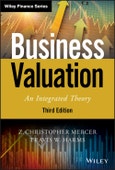A guide that demystifies modern valuation theory and shows how to apply fundamental valuation concepts
The revised and updated third edition of Business Valuation: An Integrated Theory explores the core concepts of the integrated theory of business valuation and adapts the theory to reflect how the market for private business actually works.
In this third edition of their book, the authors - two experts on the topic of business valuation - help readers translate valuation theory into everyday valuation practice. This important updated book:
- Includes an extended review of the core concepts of the integrated theory of business valuation and applies the theory on a total capital basis
- Explains “typical” valuation discounts (marketability and minority interest) and premiums (control premiums) in the context of financial theory, institutional reality and the behavior of market participants
- Explores evolving valuation perspectives in the context of the integrated theory
- Written by two experts on valuation theory from Mercer Capital
The third edition of Business Valuation is the only book available regarding an integrated theory of business valuation - offering an essential, unprecedented resource for business professionals.
Table of Contents
Introduction xiii
What’s New in the Third Edition? xiv
Who Should Read This Book? xvii
Part One Conceptual Overview of the Integrated Theory
Chapter 1 The World of Value 3
Introduction 3
Common Questions 3
The World of Value 4
The Organizing Principles 5
Summary 16
Chapter 2 The Integrated Theory (Equity Basis) 19
Introduction 19
Common Questions 20
The Fundamental Valuation Model 21
The Conceptual Levels of Value 23
Symbolic Notation for the Integrated Theory 27
The Marketable Minority Interest Level of Value 29
Introduction to the Control Levels of Value 35
Strategic Control Level of Value 51
Firmwide Levels versus the Shareholder Level of Value 58
The Nonmarketable Minority Level of Value 60
The Integrated Theory of Business Valuation on an Equity Basis 67
Summary 67
Chapter 3 The Integrated Theory (Enterprise Basis) 71
Introduction 71
Comparing the Levels of Value: Equity and Enterprise Bases 73
Final Comparisons of the Equity and Enterprise Bases 77
Summary 79
Part Two Valuing Enterprise Cash Flows
Chapter 4 Income Approach (Cash Flows) 83
Introduction 83
Reconciling Single-Period Capitalization and Discounted Cash Flow Methods 84
Defining Enterprise Cash Flows 90
Defining Equity Cash Flows 95
Reinvestment Rates and Interim Growth Rates 99
Terminal Growth Rates 104
Expected Cash Flows and the Integrated Theory 108
Marketable Minority Interest Level: Public Company Equivalent 115
Financial Control Level: Private Equity Cash Flows 124
Strategic Control Level: Strategic Acquirer Cash Flows 128
Assessing the Reasonableness of Projected
Enterprise Cash Flows 136
Conclusion 139
Chapter 5 Income Approach (Discount Rate) 141
Introduction 141
Return Basics: Realized versus Required Returns 142
Components of the Weighted Average Cost of Capital 148
Market Participants and the WACC 165
The Levels of Value and the WACC 169
Assessing Overall Reasonableness 175
Chapter 6 Market Approach (Guideline Public Companies) 177
Introduction 177
Relationship of the Income and Market Approaches 178
What Do Observed Public Company Valuation Multiples Mean? 180
Adjusting Valuation Multiples for Differences in Risk and Growth 199
Guideline Public Company Multiples and the Enterprise Levels of Value 214
Assessing Overall Reasonableness 219
Chapter 7 Market Approach (Guideline Transactions) 221
Introduction 221
Attributes of Guideline Transaction Data 222
Drawing Valuation Inferences from Guideline Transaction Data 225
Minority Interest Discounts Inferred from Observed Control Premiums 240
Guideline Transaction Multiples and the Levels of Value 242
Assessing Overall Reasonableness 244
Appendix 7-A: A Historical Perspective on the Control Premium and Minority Interest Discount 247
Part Three Valuing Shareholder Cash Flows
Chapter 8 Restricted Stock Discounts and Pre-IPO Studies 271
Introduction 271
An Overview of Restricted Stock Discounts 275
Review of the FMV/Stout Restricted Stock Database 306
Pre-IPO Discounts 317
Conclusion 325
Chapter 9 Introduction to the QMDM (Quantitative Marketability Discount Model) 327
Introduction 327
Potential Valuation Approaches at the Shareholder Level 328
A Shareholder Level Discounted Cash Flow Model in Outline 331
Economic Factors Giving Rise to the Marketability Discount 338
Conclusion 346
Appendix 9-A: Liquidity and Marketability 349
Chapter 10 The QMDM Assumptions in Detail 359
Introduction 359
Assumption 1: Expected Holding Period for the Investment (HP) 360
Assumption 2A: Expected Dividend Yield (D %) 368
Assumption 2B: Expected Growth of Dividends (GD) 377
Assumption 2C: Timing of Dividend Receipt 378
Assumption 3A: The Expected Growth Rate in Value (GV) 379
Assumption 3B: Adjustments to the Terminal Value 385
Assumption 4: Required Holding Period Return (Rhp) 385
Conclusion 399
Chapter 11 Applying the QMDM 401
Introduction 401
Comprehensive Example of the QMDM in Use 401
Condensed QMDM Examples 414
The Uniform Standards of Professional Appraisal Practice and the QMDM 427
Chapter 12 Applying the Integrated Theory to Tax Pass-Through Entities 435
Introduction 435
The Nature of the S Corporation Benefit 437
The Firmwide Level Value of S Corporations 440
Other Observations Regarding Relative Value at the Firmwide Levels 443
The Shareholder Level Value of S Corporations 446
S Corporations and the Tax Cuts and Jobs Act of 2017 458
Conclusion 467
About the Authors 469
Index 477








